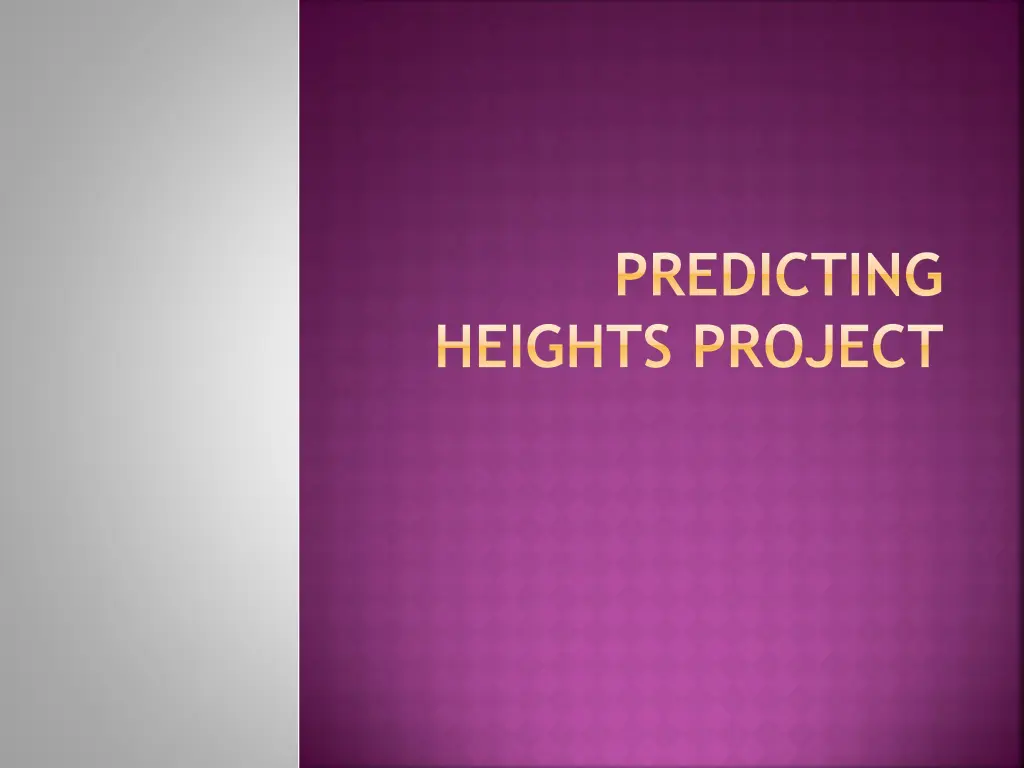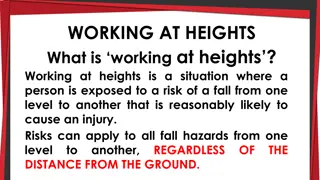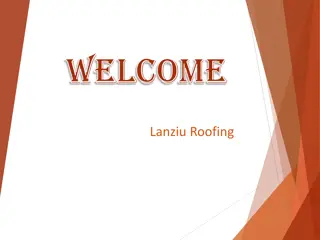
Data Analysis: Predicting Heights Project Insights
Explore the relationship between height and body measurements like lower leg and wrist circumference in the Predicting Heights Project. Analyze data by gender to understand correlations and fit of linear models for males and females. Compare male and female data to gain valuable insights.
Uploaded on | 0 Views
Download Presentation

Please find below an Image/Link to download the presentation.
The content on the website is provided AS IS for your information and personal use only. It may not be sold, licensed, or shared on other websites without obtaining consent from the author. If you encounter any issues during the download, it is possible that the publisher has removed the file from their server.
You are allowed to download the files provided on this website for personal or commercial use, subject to the condition that they are used lawfully. All files are the property of their respective owners.
The content on the website is provided AS IS for your information and personal use only. It may not be sold, licensed, or shared on other websites without obtaining consent from the author.
E N D
Presentation Transcript
PREDICTING HEIGHTS PROJECT
INTRODUCTION Our group measured Arm length- From shoulder to farthest finger tip. Wrist circumference- Wrapped tape measure around the subject s wrist. Lower Leg- (Had subject sit down) From top of knee to ankle. Actual height and gender were also collected.
HEIGHT VS. LOWER LEG Describe graph (form, direction, strength) Give correlation value (r) LSR line Interpret slope Interpret r-squared Describe residual plot (form, outliers) Is the linear model appropriate? Use correlation, residual plot, and original plot
FEMALES AND LOWER LEG FEMALES: Describe female plot List Female LSR line List female correlation List female r-squared Describe female resid plot and comment on fit of linear model for females
MALES & LOWER LEG MALES: Describe male plot List male LSR line List male correlation List male r-squared Describe male resid plot and comment on fit of linear model for males
HEIGHT VS. WRIST CIRCUMFERENCE Describe graph (form, direction, strength) Give correlation value (r) HEIGHT = a + b(wrist circ) Interpret slope Interpret r-squared Describe residual plot (form, direction, strength) Is the linear model appropriate? Use correlation, residual plot, and original plot
HEIGHT AND WRIST CIRCUMFERENCE BASED ON GENDER Same gender analysis as before See slides 5 8
Describe graph (form, direction, strength) Give correlation value (r) HEIGHT = a + b(arm length) Interpret slope Interpret r-squared Describe residual plot (form, direction, strength) Is the linear model appropriate? Use correlation, residual plot, and original plot
HEIGHT AND ARM LENGTH BASED ON GENDER Same gender analysis as before See slides 5 8
BEST OVERALL MODEL LOWER LEG Justify choice
BEST MODEL FOR EACH GENDER Justify choices
OUR PREDICTED HEIGHTS (use gender specific models) Partner #1 Lower leg measurement = 17.5 inches Height = 21.2 + 2.68(17.5) = 68.1 inches Actual Height = 64 inches Residual = 64 68.1 = -4.1 inches Overestimate Partner #2 Lower leg measurement = 18 inches Height = 21.2 + 2.68(18) = 69.44 inches Actual Height = 67 inches Residual = 67 69.44 = -2.44 inches Overestimate Partner #3 Lower leg measurement = 17.5 inches Height = 21.2 + 2.68(17.5) = 68.1 inches Actual Height = 71 inches Residual = 71 68.1 = 2.9 Underestimate
PREDICTED TEACHER HEIGHTS (use gender specific models) Mrs. McNelis Height = 2.68(17.5) + 21.2 = 68.1 inches Mrs. Ladley Height = 2.68(17.5) + 21.2 = 68.1 inches Mr. Smith Height = 5.2(17) + 10.4 = 66.8 inches Mrs. Tannous Height = 2.68(17.5) + 21.2 = 68.1 inches Miss Gemgnani Height = 2.68(17.5) + 21.2 = 68.1 inches Mrs. Bolton Height = 2.68(17) + 21.2 = 66.8 inches
CONFIDENCE State how confident you are in your predictions of the guest teachers, and JUSTIFY WHY!
LINREG T TEST (ON BEST MODEL) Create linear model for best measurement and copy onto ppt
Do lin Reg t test using the output above Ho: 1 = 0 Ha: 1>, <, 0 Conditions (with graphs! Do not say see previous slides ) & statement t = b1 0 = # SEb P(t > ______|df = n 2) = We reject Ho . We have sufficient evidence Therefore
LIN REG CONFIDENCE INTERVAL Since we rejected Ho, we need to complete a conf. int. Statement b + t*(SEb) = (____, ____) We are 90% confident that for every 1 X variable unit increase, the Y variable increases btw ____ and ____ units on average.
ANALYSIS OF GENDER HEIGHTS Summary Stats: (do not copy this table from Fathom. Instead, type these on your slide neatly) Collection 1 gender gender Row Summary F M 64.5278 69.3561 67.2364 18 62 63 23 41 62 65.5 68 69 71.5 73.5 64.5 67.5 69 73.5 height 64.25 66 68.5 1.85085 2.26593 3.18825 S1 = mean S2 = count S3 = min S4 = Q1 S5 = median S6 = Q3 S7 = max S8 = s
2 SAMPLE T TEST ON THE MEAN HEIGHT OF MALE/FEMALE Ho: males = females Ha: males females Conditions & statement t = mean1 mean2 = s12 + s22 n1 n2 2* P(t > _______| df = ___) = We reject .. We have sufficient evidence .
CONFIDENCE INTERVAL If you reject Ho, complete an appropriate confidence interval
ANALYSIS OF ARM LENGTH BY GENDER Collection 1 DO NOT put this type of table on your power point!! Write out the numbers neatly. Gender Gender Row Summary F M 19 23 42 26.2632 1.51262 28.587 1.50493 27.5357 1.89477 24 25 26 28 26 24 26 28 29 31 Arm_Length 27.5 28 30 31 29.5 S1 = count S2 = mean S3 = s S4 = min S5 = Q1 S6 = median S7 = Q3 S8 = max
2 SAMPLE T TEST ON THE MEAN ARM LENGTH OF MALE/FEMALE Ho: males = females Ha: males females Conditions & statement t = mean1 mean2 = s12 + s22 n1 n2 2* P(t > _______| df = ___) = We reject .. We have sufficient evidence .
CONFIDENCE INTERVAL If you reject Ho, complete an appropriate confidence interval
BIAS AND ERRORS List and explain possible sources of bias and error in your project.
CONCLUSION Make conclusions about ALL of your data analysis Each measurement Each test of significance and confidence interval Overall conclusion about predicting heights Can be a bulleted list with explanation






















